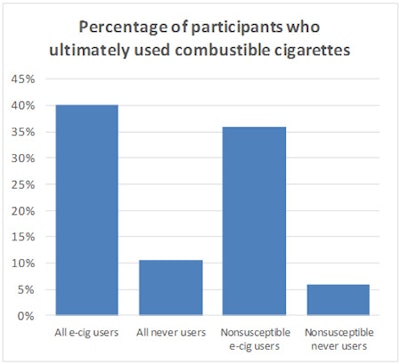
Teenagers who use e-cigarettes are significantly more likely to go onto smoke regular cigarettes, according to a new study. The researchers found this was true even if the teenagers were at an otherwise low risk of using conventional cigarettes.
The Los Angeles-based authors focused on high school juniors and seniors, who were on the cusp of turning 18 and being able to legally purchase cigarettes. They wanted to know if adolescents who used e-cigarettes, but not traditional cigarettes, had higher odds of smoking combustible tobacco products as they got older. Their findings were published in Pediatrics (Jul 2016, Vol. 138:1, p. e20160379).
"Our findings ... suggest that e-cigarette use is a clear and consistent indicator of likelihood of subsequent initiation of cigarette and other combustible tobacco product use at ages spanning from early adolescence through emerging adulthood," wrote lead study author Jessica Barrington-Trimis, PhD, and colleagues from the department of preventive medicine at the University of Southern California.
E-cigarettes can lead to regular ones
While it is established that smoking traditional cigarettes is detrimental to overall and oral health, the role e-cigarettes play as a gateway product to combustible cigarettes hasn't been as readily studied. Barrington-Trimis and colleagues decided to pursue this question, particularly as no researchers had previously focused on older adolescents who would soon be able to legally purchase cigarettes.
"A critical question is whether e-cigarette use in adolescents who have never smoked cigarettes will lead to subsequent initiation of cigarette or other combustible product use," the authors wrote.
They began by looking at cigarette use data for 11th- and 12th-grade high school students in Southern California. They used information from the 2014 Southern California Children's Health Study, which was collected during the spring semester of 2014.
“E-cigarette use is likely introducing new youth to tobacco products and is increasing the likelihood of future smoking among the low-risk group.”
Then, from late 2015 to early 2016, the researchers sent a follow-up survey to all former 11th-and 12th-grade students who had never smoked a regular or e-cigarette (never users), as well as those who had smoked an e-cigarette but not a regular one (e-cigarette users). They ended up with 152 never users and 146 e-cigarette users in their final analysis. All of those in the follow-up survey were at least 18 years old and able to legally purchase combustible cigarettes.
Barrington-Trimis and colleagues found that those who used e-cigarettes in high school had more than six times the odds of using regular cigarettes later on. Students who smoked e-cigarettes were also more likely to use any combustible tobacco product, including cigars and pipes.
"These findings suggest that e-cigarette use may promote smoking during the transition to adulthood, even in those considered to be at lower risk because of personal or environmental factors," the authors wrote.
Furthermore, the researchers found the risk of smoking combustible cigarettes was higher even among those who had reported no intention to smoke while in high school. Specifically, 36% of e-cigarette users who were considered nonsusceptible to regular cigarettes ended up smoking combustible cigarettes, while only 6% of nonsusceptible nonusers went on to smoke cigarettes.

"Together, these findings suggest that e-cigarettes are not merely a marker for individuals who would have gone on to smoke combustible cigarettes, regardless of the availability of e-cigarettes," the authors wrote, "but that e-cigarette use is likely introducing new youth to tobacco products and is increasing the likelihood of future smoking among the low-risk group who expressed confidence that they would not do so."
Researchers want to know why
While this study suggests that e-cigarettes may be a gateway to regular cigarettes, the authors noted there are some uncertainties to the study's conclusions. Foremost, the study only looked at students in the Southern California area, and the results may not be able to be generalized to adolescents in other areas. The authors were also only able to include participants who answered the follow-up survey, and those who didn't respond to the follow-up were less likely to have a parent with at least a college education.
Barrington-Trimis and colleagues hope future researchers get more information about the type of e-cigarette used, as well as the nicotine content, for high school students. They also believe further research is needed to understand why e-cigarette use may influence combustible cigarette use.
"This research adds much needed data to the emerging evidence that e-cigarettes are associated with increased risk of smoking among adolescents," the authors concluded. "Because e-cigarette use in common in adolescents and young adults, further prospective follow-up of this and other cohorts is needed to determine whether e-cigarette use will increase population rates of cigarette and other combustible tobacco products and their associated burden of disease."



















